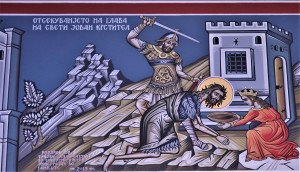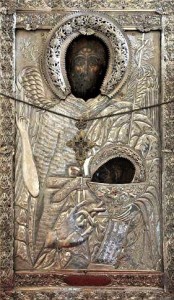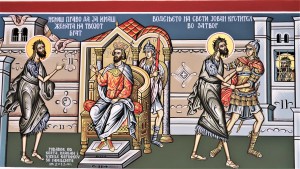THE BEHEADING OF SAINT JOHN THE BAPTIST
Refer : MATTHEW 14:1-12
Herod Antipas, son of the elder Herod, who was the slayer of the children of Bethlehem at the time of the birth of the Lord Jesus, was the ruler of Galilee at the time when John the Baptist was preaching. This Herod was married to the daughter of Aretas, an Arabian prince. But Herod, an evil sprout of an evil root, cast out his lawful wife and unlawfully took Herodias as his concubine, the wife of his brother Philip, who was still alive.
Saint John the Baptist stood up against this lawlessness and strongly denounced Herod who then cast Saint John into prison.
At the time of a banquet in his court in Sebastia in Galilee Salome, the daughter of Herodias and Philip, danced before the guests. The drunken Herod was so taken by this dance that he promised Salome that he would give her whatever she asked of him, even if it would be, half of his kingdom. Being persuaded by her mother, Salome asked for the head of John the Baptist.
 Herod gave the order and John was beheaded in prison and his head brought to him on a platter. John’s disciples took the body of their teacher by night and honorably buried it and Herodias pierced the tongue of Saint John the Baptist with a needle in many places and buried the head in an unclean place.
Herod gave the order and John was beheaded in prison and his head brought to him on a platter. John’s disciples took the body of their teacher by night and honorably buried it and Herodias pierced the tongue of Saint John the Baptist with a needle in many places and buried the head in an unclean place.
What later happened to John the Baptist’s head can be read under February 24. However, God’s punishment quickly befell this group of evildoers. Prince Aretas, in order to cleanse his daughter’s honour, attacked Herod with his army and defeated him. The defeated Herod was sentenced by the Roman Caesar, Caligula, to exile at first to Gaul and later to Spain. As exiles, Herod and Herodias lived in poverty and humiliation until the earth opened up and swallowed them. Salome died an evil death on the Sikaris (Sula) river. The death of St. John occurred before the Pascha [Passover] but its celebration on August 29 was established because, on that day, a church which had been built over his grave in Sebastia by Emperor Constantine and Empress Helena was consecrated. In this church, the relics of John’s disciples, Eliseus and Audius, were also placed.


